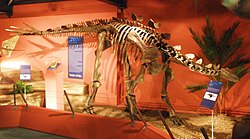Miragaia (dinosaur)
|
Miragaia Temporal range: Late Jurassic, 150 Ma |
|
|---|---|
 |
|
| Skeleton model | |
| Scientific classification | |
| Kingdom: | Animalia |
| Phylum: | Chordata |
| Class: | Reptilia |
| Clade: | Dinosauria |
| Order: | †Ornithischia |
| Suborder: | †Stegosauria |
| Family: | †Stegosauridae |
| Genus: |
†Miragaia Mateus et al., 2009 |
| Species: | †M. longicollum |
| Binomial name | |
|
Miragaia longicollum Mateus et al., 2009 |
|
Miragaia (named after Miragaia, the parish in Portugal and geologic unit where its remains were found) is a genus of herbivorous stegosaurid dinosaur. Its fossils have been found in Upper Jurassic rocks in Portugal. Miragaia has the longest neck known for any stegosaurian, which included at least seventeen vertebrae.
Miragaia is based on holotype ML 433, a nearly complete anterior half of a skeleton with partial skull (the first cranial material for a European stegosaurid). The remains were found after the construction of a road between the villages of Miragaia and Sobral. The rear half of the skeleton was probably destroyed by the roadcut. The fossils were dug up in August 1999 and August 2001. Among the recovered bones were most of the snout, a right postorbital, both angulars of the lower jaws, fifteen neck vertebrae (the first two, which articulated with the skull, were absent), two anterior dorsal vertebrae, twelve ribs, a chevron, the shoulder bones, most of the forelimbs including a possible os carpi intermedium, a right first metacarpal and three first phalanges; and thirteen bony plates plus a spike. The bones were not articulated but dispersed over a surface of about five to seven metres, though there was a partial concentration of fossils that could be salvaged within a single block. ML 433 was found in the Miragaia Unit of the Sobral Unit, Lourinhã Formation, which dates to the late Kimmeridgian-early Tithonian (Late Jurassic, approximately 150 million years ago).
...
Wikipedia
